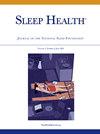检查有和没有多动症的青少年的学校气氛和睡眠。
IF 3.4
2区 医学
Q2 CLINICAL NEUROLOGY
引用次数: 0
摘要
目的:尽管睡眠问题被广泛认为是青少年的公共卫生问题,但患有注意力缺陷/多动障碍的青少年睡眠困难的风险很高。鉴于越来越多的证据支持其与健康结果的关联,学校气氛对睡眠困难的影响可能至关重要,但尚未得到充分研究。本研究首次利用多方法、多信息的方法,包括青少年报告、家长报告和活动记录法,来研究有或没有注意缺陷/多动障碍的青少年的学校气氛和睡眠功能的不同方面之间的联系。方法:参与者包括一个特征明确的青少年样本(45.1%女性,82.6%白人),有注意缺陷/多动障碍(n = 151)和没有注意缺陷/多动障碍(n = 137),年龄在13 - 15岁之间(M = 14.09)。结果:控制人口统计学特征、内化症状和药物使用的多组路径分析表明,无论注意力缺陷/多动障碍状态如何,更好地感知学校气候与青少年报告的较少的白天嗜睡和较少的睡眠/觉醒问题相关,尽管在非注意力缺陷/多动障碍组中发现了更强的关联。相比之下,对于有或没有注意缺陷/多动障碍的青少年,学校气氛与青少年或活动记录仪测量的睡眠时间、活动记录仪评估的睡眠效率或家长报告的睡眠质量没有显著关联。结论:总的来说,研究结果表明,学校氛围与睡眠的特定方面或广泛方面有关,并且这种联系可能因睡眠评估方式而异。研究结果还为支持学校氛围对青少年睡眠质量的重要性提供了新的证据基础。本文章由计算机程序翻译,如有差异,请以英文原文为准。
Examining school climate and sleep in adolescents with and without ADHD
Objectives
Adolescents with attention-deficit/hyperactivity disorder are at high risk for sleep difficulties, though sleep problems are widely recognized as a public health concern for adolescents broadly. School climate represents a potentially critical but understudied influence on sleep difficulties, given growing evidence supporting its association with health outcomes. The present study is the first to utilize a multimethod, multi-informant approach, including adolescent-report, parent-report, and actigraphy, to examine associations between school climate and different aspects of sleep functioning among adolescents with and without attention-deficit/hyperactivity disorder.
Methods
Participants included a well-characterized sample of adolescents (45.1% female, 82.6% White) with attention-deficit/hyperactivity disorder (n = 151) and without attention-deficit/hyperactivity disorder (n = 137) between 13 and 15 years old (M = 14.09).
Results
Multigroup path analyses controlling for demographic characteristics, internalizing symptoms, and medication use indicated better-perceived school climate was associated with less adolescent-reported daytime sleepiness and fewer sleep/wake problems, regardless of attention-deficit/hyperactivity disorder status, though stronger associations were found in the non-attention-deficit/hyperactivity disorder group. In contrast, for both adolescents with and without attention-deficit/hyperactivity disorder, school climate was not significantly associated with adolescent- or actigraphy-measured sleep duration, actigraphy-assessed sleep efficiency, or parent-reported sleep quality.
Conclusions
Collectively, findings indicate school climate is associated with specific vs. broad-based aspects of sleep, and that associations may differ based on how sleep is assessed. Findings also contribute to an emerging evidence base supporting the importance of school climate to adolescent sleep quality.
求助全文
通过发布文献求助,成功后即可免费获取论文全文。
去求助
来源期刊

Sleep Health
CLINICAL NEUROLOGY-
CiteScore
6.30
自引率
9.80%
发文量
114
审稿时长
54 days
期刊介绍:
Sleep Health Journal of the National Sleep Foundation is a multidisciplinary journal that explores sleep''s role in population health and elucidates the social science perspective on sleep and health. Aligned with the National Sleep Foundation''s global authoritative, evidence-based voice for sleep health, the journal serves as the foremost publication for manuscripts that advance the sleep health of all members of society.The scope of the journal extends across diverse sleep-related fields, including anthropology, education, health services research, human development, international health, law, mental health, nursing, nutrition, psychology, public health, public policy, fatigue management, transportation, social work, and sociology. The journal welcomes original research articles, review articles, brief reports, special articles, letters to the editor, editorials, and commentaries.
 求助内容:
求助内容: 应助结果提醒方式:
应助结果提醒方式:


